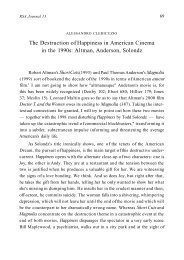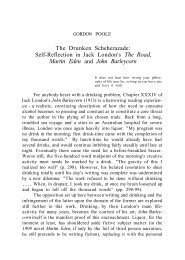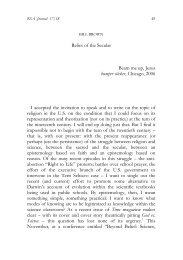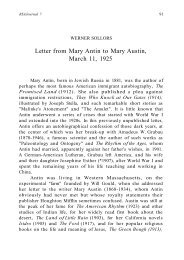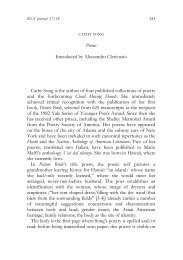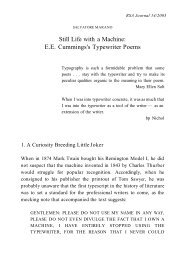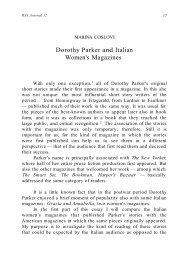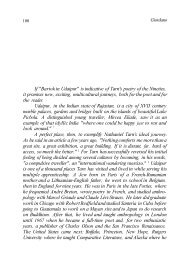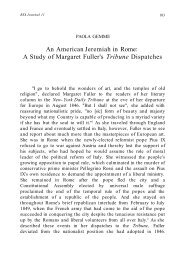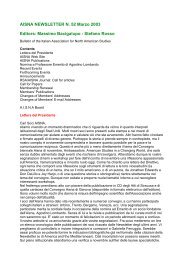Myth and Carnival in Robert Coover's The Public Burning - aisna
Myth and Carnival in Robert Coover's The Public Burning - aisna
Myth and Carnival in Robert Coover's The Public Burning - aisna
- No tags were found...
Create successful ePaper yourself
Turn your PDF publications into a flip-book with our unique Google optimized e-Paper software.
RSA Journal 321so she burns—<strong>and</strong> burns—<strong>and</strong> burns—as though held aloft by her own<strong>in</strong>c<strong>and</strong>escent will <strong>and</strong> haloed about by all the gleam<strong>in</strong>g great of thenation... (PB 517)A certa<strong>in</strong> purification could be seen <strong>in</strong> Ethel's turn<strong>in</strong>g <strong>in</strong>to aSa<strong>in</strong>t-like figure—America renew<strong>in</strong>g its "s<strong>in</strong>k<strong>in</strong>g spirit" <strong>in</strong> the avatarof the f<strong>in</strong>al fireworks. Nonetheless, purification should be understoodhere <strong>in</strong> terms of irony. Uncle Sam's brutality is modulated by Nixon'sdoubt about right <strong>and</strong> truth; the burn<strong>in</strong>g is negated <strong>and</strong> enjoyed by acritical use of the Times Square theater which, to be sure, "burns" <strong>and</strong>punishes not so much the Rosenbergs, who are transformed <strong>in</strong>to angels,but the "evil" of America <strong>and</strong> its agents. <strong>The</strong> quiver<strong>in</strong>g flame of<strong>Coover's</strong> public burn<strong>in</strong>g, like Canetti's Autodafé, explodes the unity ofUncle Sam's mythological episteme by recreat<strong>in</strong>g a story never beforenarrated by official documents. <strong>The</strong> absoluteness of the myth isdestroyed, its violence denounced, its consistency burned away. <strong>Coover's</strong>fiction takes the place left vacant by myth, but this fiction isconscious of the divide between itself <strong>and</strong> the facts it pretends tonarrate; the three-dimensionality of the narration (<strong>Coover's</strong>, Nixon's,<strong>and</strong> Uncle Sam's diegetic po<strong>in</strong>ts of view) dissipates the oppressivethemes of an omniscient monologism through the exuberant irony of anexemplary fiction.1 Hereafter, all references to <strong>Coover's</strong> <strong>The</strong> <strong>Public</strong> Burn<strong>in</strong>g (PB) will be given <strong>in</strong>brackets <strong>in</strong> the text.2 On the Mormon <strong>in</strong>fluence on American politics <strong>and</strong> mythology, see HaroldBloom.3 "I was develop<strong>in</strong>g this series of circus acts—all these verbal acrobatics,death-defy<strong>in</strong>g highwire acts, showy parades, <strong>and</strong> so on—<strong>and</strong> I needed a clown to break<strong>in</strong> from time to time <strong>and</strong> do a few pratfalls. He [Nixon] was perfect for this. For awhile, anyway. Eventually his real-life pratfalls nearly undid my own. I couldn't keepup with him... the Watergate episode forced me to work a lot harder, dig deeper, th<strong>in</strong>kbeyond the pratfalls" (McCaffery 75).4 In the McCaffery <strong>in</strong>terview, Coover describes Nixon as follows: "he's such aself-conscious character. He has to analyze everyth<strong>in</strong>g, work out all parameters. Heworries about th<strong>in</strong>gs—<strong>and</strong> then there is his somewhat suspicious view of the world...This attitude of his allowed me to reach skeptical conclusions through him about whatwas happen<strong>in</strong>g at the time of the Rosenberg executions, conclusions which would have



